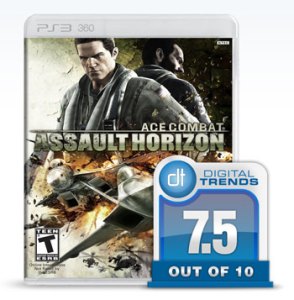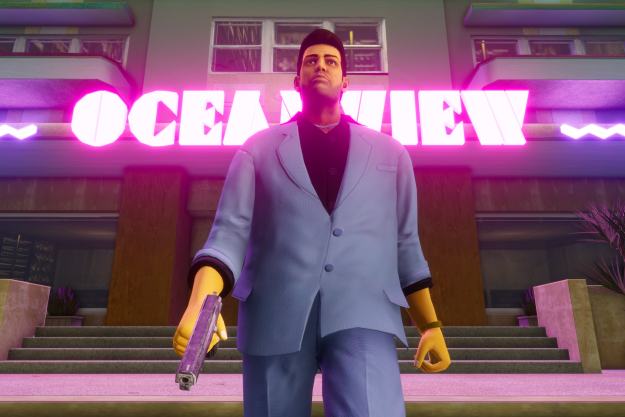 When it comes to video games, there are fewer options for flying games than you would think. It seems like a natural fit: Take one of the most exciting and wild things a human can do—i.e. strap yourself into what is essentially a steerable missile capable of going so fast that the screams of an unprepared passenger would travel at a snail’s pace by comparison–and allow people to control it from the safe confines of their couch. Toss in a few ‘splosions and what more could you ask for from a video game? You have combat, speed and the ability to simulate something most of us dream of but will never do, and yet the flying game genre has always been somewhat sketchy at best.
When it comes to video games, there are fewer options for flying games than you would think. It seems like a natural fit: Take one of the most exciting and wild things a human can do—i.e. strap yourself into what is essentially a steerable missile capable of going so fast that the screams of an unprepared passenger would travel at a snail’s pace by comparison–and allow people to control it from the safe confines of their couch. Toss in a few ‘splosions and what more could you ask for from a video game? You have combat, speed and the ability to simulate something most of us dream of but will never do, and yet the flying game genre has always been somewhat sketchy at best.
Near the head of the pack though has always been the Ace Combat series. While people could argue for hours over whether it is the best flying game franchise on the console (despite the series originating with an arcade game), they were certainly among the most popular—and have been since the series debuted on the PS One.
But somewhere along the line they lost their mojo. Maybe it was a combination of the games themselves and players simply tiring of the flying genre, but the franchise settled into a bit of a funk. The last console game, Ace Combat 6: Fires of Liberation was well received, but not a major hit. So Namco Bandai and Project Ares decided to give the property a facelift. In essence, they Call of Duty-ified the series. They brought in Jim DeFelice, a NY Times bestselling war novelist, added a much more cinematic real world presentation and mixed the combat up to include levels with helicopters and AC-130s—which have appeared in Call of Duty. And, of course, then you have the jet missions, which are the core of the game.

Callsign of Duty
Set in the near future of 2015, Ace Combat: Assault Horizons follows a handful of characters that are part of NATO’s 108th Task Force. The 108th have been deployed to Africa to help combat an insurgency that is growing at an alarming pace. Then while on a peacekeeping mission (“peacekeeping” being a code word for “blow stuff up”) a new weapon called “Trinity” with an explosive yield just shy of a nuclear blast is discovered.
As the NATO pilots try to hunt down the source of the Trinity weapon, a group of rogue Russian radicals retaliate (trying saying that five times fast) against the 108th, and the battle rages across the world from Africa to South America to the United States.
The story is a definite highlight of AC:AH–even though it is a bit cliched and maybe a touch too familiar. There are plenty of twists and turns, including the realization of what the Russians are planning, but most of it will ring familiar. And although the majority of the time the game is spent in the cockpit of Lt. Col. William Bishop, the occasional shift to alternate characters, including crewmen on a stealth bomber, a helicopter gunner and an AC-130 help to expand the story and give it a sense of scale.
In terms of presentation, the game is solid. The graphics aren’t amazing, but they are serviceable. The sound is a definite highlight though, especially the music—you know a soundtrack to a game is good when it is one of the special offers for buying the limited edition—and if you are planning to buy the game, it is worth looking for the limited edition with the soundtrack. The music alone makes AC:AH a better game. The voice acting is also well done.

The look of the game also changes quite a bit, from the barren deserts of Africa to crowded metropolises like Miami. They all look fine, but none will blow you away–it’s just the lack of detail. Cities will be deserted, and there are no cars on the street or billboards. The environments look fine, but they also look sterile. Changing the series from the fictional settings of Durka-Durkastan or wherever, to the real world is a nice change for the series though.
Stay on Target…
The gameplay is going to be a bit of a dividing factor for people. Those (like me) that prefer flight games that have a bit more of a simulation feel may chafe a bit at the simplified controls. At the very least it takes some getting used to. The flipside is that newer players may find it more accessible and forgiving.
The helicopter gunner, AC-130, gunner and bomber missions are all fairly short and are on rails for the most part, leaving the bulk of the flying to the jets. You do occasionally take control of other aircraft, but it is typically a brief alternative to the bulk of the game. Flying a jet is a fairly simple matter, as all the movement—with the exception of the pitch and yaw which are important but not crucial—are handled through a single analog stick. There is the option to change to an “original” setting, but the main difference is just the ability to roll, at the cost of some stability.
The flight controls feel fine, but never great. They just feel a bit flat and uninspired and there are very few “that was awesome!” moments as you pull off incredible maneuvers. The dogfights can be very cool though, but the actual act of flying is average.
A crucial new addition to the series is the Dogfight Mode (DFM). When you are close to an enemy jet, you activate the DFM by hitting two buttons, and your plane essentially locks on to the enemy. The enemy can still break free, but not easily. You remain in this mode until either you or the enemy breaks it off, or you destroy your prey. A similar mechanic called Air Strike Mode (ASM) exists for attacking ground targets.

In the early stages especially, the repetition is an issue. You may face off against a dozen planes, which instead of creating a wild and frantic air battle where anything can happen, ends up with you clicking the DFM, firing, and moving on to the next target again and again. As the game progresses the mission variety increases, as do the enemies, which makes it far more fun than in the beginning. When you are in the DFM, you are also vulnerable to more attacks. When the game really heats up, you will need to initiate DFM, fire a few missiles, then immediately switch to another target or make a break for it. That’s when the game is a bit more fun.
There is regenerative health as well, which is a bit odd for a wanna-be realistic flight game, but no more so than a fighter holding around 300 missiles.
As for the firing, homing missiles are your best friend. You do have more special weapon options, but the homing missiles are far and away the most useful. It is also possible to shoot down an enemy with guns, but this will usually be a very last resort. It’s the equivalent of only having a pistol to fight a boss in a first-person shooter.
The helicopter missions are an interesting addition, although they are a small percent of the overall game. The controls are fairly basic, but attacking countless ground targets in a whirling death machine is something of a perverse pleasure. The other missions are more-or-less on-rails, and are a fun diversion, but not much more. The AC-130 mission is a highlight—just like it was in Call of Duty 4: Modern Warfare. It is very similar, down to the look. The AC:AH AC-130 missions aren’t quite as fun though.

Shut up, Ice Man
The level of difficult ramps up significantly in later missions, which is a good and bad thing. It is good because it makes the combat more tense, but it is bad because the friendly AI is borderline brain dead. At the very least they are pacifists, as they seem either unable or unwilling to seriously attack a single enemy. They may engage, and then the enemy and your wingman will begin a beautiful dance, sort of like the Blue Angles. At least until you blow one of them up.
That isn’t a huge issue at first. Your teammates will keep enemies away from you when they can, so it means more bogies for you to shout in a manly voice “Fox one” as you send missiles to kiss the enemies with a sweet death. When the missions are timed, however, your wingmen are utterly worthless. They don’t help in the least, and there really isn’t a single reason for them to be there, with the possible exception of occasionally becoming cannon fodder. Their chatter also becomes a bit redundant, since they aren’t really doing much.

Conclusion
The change in setting to include real world locations may be enough on its own to appeal to hardcore fans of the series. The story is solid—albeit very familiar at times—and the missions have enough variety to keep the feeling of repetition down a bit. The DFM is an interesting inclusion, and becomes a vital one as well since it is extremely difficult to destroy enemies without it.
The gameplay is much the same as the last Ace Combat title, but it is much different from other flight sims, including the older games in the franchise. It is more accessible, but it’s at the cost of a bit of the freedom. Sure, that freedom typically ended with me breaking the sound barrier as I crashed nose first into the ground, so maybe that isn’t a bad thing.
Fans of the series and flight sim fans that have been craving something new should check out AC:AH. The music is also a highlight, and is among the best gaming soundtracks of the year, which actually makes a difference in setting the tone of missions. For everyone else, Ace Combat: Assault Horizon is good for a few quick flybys, but probably won’t keep your interest for long.
Score 7.5 out of 10
(This game was reviewed on the Xbox 360 on a copy provided by Namco Bandai)


